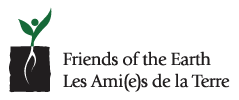Taking a Bumble Bee Census
By Mireille Gauthier | Research assistant at Friends of the Earth
The Great Canadian Bumble Bee Count offers educational material to help people learn about our 40+ species of bumble bees and submit their photos and observations as part of our census. By spending time in gardens, fields, forests and parks looking for bumble bees and learning about how to protect them, we’re hoping people will become as familiar with the Yellow-banded bumble bee (Bombus terricola) as they are with Monarch butterflies.
Recently, we learned from our opinion poll that Canadians care deeply about the welfare of bees but know very little about the over 850 native wild bee species. This strengthens our interest in getting more people out taking pictures of bumble bees and submitting them with observations to the Great Canadian Bumble Bee Count, now in its second year.
In 2016, we received over 1,200 bumble bee photos and observations from across Canada – everywhere from urban backyard gardens to agricultural areas. We heard bumble bee stories at farmers’ markets, eco-festivals, education sessions, photography workshops, and through social media.
 Because of the diversity of locations and plant hosts, we received a variety of bumble bee species, with the most common being the Common Eastern Bumble Bee (Bombus impatiens). In addition, there were plenty of Tri-coloured bumble bees (Bombus ternarius) submitted from Eastern Canada, and many Western bumble bees (Bombus occidentalis) submitted from the West coast. This matches the general scientific knowledge about the abundance of these species in their respective areas. We received enough bee count submissions to mirror some of the standard trends that ecologists have found – this adds to the importance of doing these kinds of counts.
Because of the diversity of locations and plant hosts, we received a variety of bumble bee species, with the most common being the Common Eastern Bumble Bee (Bombus impatiens). In addition, there were plenty of Tri-coloured bumble bees (Bombus ternarius) submitted from Eastern Canada, and many Western bumble bees (Bombus occidentalis) submitted from the West coast. This matches the general scientific knowledge about the abundance of these species in their respective areas. We received enough bee count submissions to mirror some of the standard trends that ecologists have found – this adds to the importance of doing these kinds of counts.
We were very excited by the 12 sightings of the Yellow-banded bumble bee (Bombus terricola), which is rare throughout much of its range and currently in decline. This species was also determined to be critically at risk by scientists from the Committee on the Status of Endangered Wildlife in Canada, which makes submissions from the Great Canadian Bumble Bee Count even more useful. Another participant submitted an American bumble bee (Bombus pensylvanicus) which is in definite decline. Participants found other uncommon bumble bees such as the Sanderson bumble bee (Bombus sandersoni), the Forest bumble bee (Bombus sylvicola), the Lemon cuckoo bumble bee (Bombus citrinus) and the Indiscriminant cuckoo bumble bee (Bombus insularis).
 Now, in 2017, we encourage anyone concerned about the welfare of bees to use our new Census Cards to try to identify the bee species they find. Last year, we received many “unknown” bee submissions, but we would like to encourage participants to try their hand at identification – it’s half the fun! Also, be on the lookout for the slight difference between the Two-spotted bumble bee (bombus bimaculatus) and the Brown-belted bumble bee (bombus griseocollis) – many people mix them up.
Now, in 2017, we encourage anyone concerned about the welfare of bees to use our new Census Cards to try to identify the bee species they find. Last year, we received many “unknown” bee submissions, but we would like to encourage participants to try their hand at identification – it’s half the fun! Also, be on the lookout for the slight difference between the Two-spotted bumble bee (bombus bimaculatus) and the Brown-belted bumble bee (bombus griseocollis) – many people mix them up.
Ontario residents submitted by far the highest number of bumble bee sightings. This year, we want to encourage other provinces to do the same because bumble bees that are at risk are scattered across the country. We recommend bee spotting at cottages and in national and provincial parks since data outside of urban areas is especially valuable.
I also want to mention a warm thank you to the Member of Parliament for Ottawa Centre who happens to be the federal Minister of the Environment and Climate Change, the Honourable Catherine McKenna – she has generously supported six students last summer and eight this summer through grants from the Canada Summer Jobs program to Friends of the Earth. It’s been a terrific experience helping to create the Great Canadian Bumble Bee Count and other programs to save the bees.
Best of luck taking bumble bee photos! We can’t wait to see your submissions!
– Mireille







